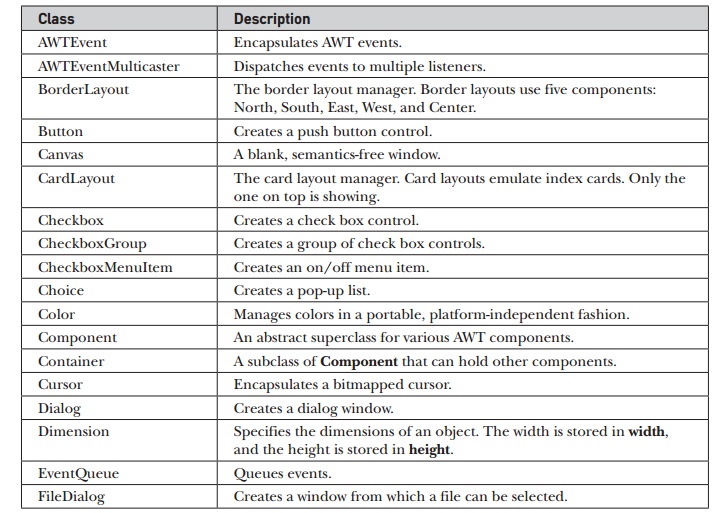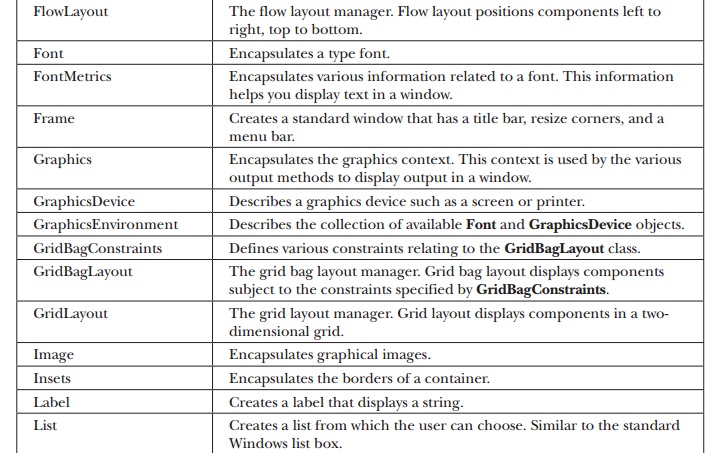Chapter: Java The Complete Reference : The Java Library : Introducing the AWT: Working with Windows, Graphics, and Text
AWT Classes
AWT Classes
The AWT classes are contained in the java.awt package. It is one of Java’s largest packages.
Fortunately, because it is logically organized in a top-down, hierarchical
fashion, it is easier to understand and use than you might at first believe.
Table 25-1 lists some of the many AWT classes.
Class : Description
AWTEvent : Encapsulates AWT events.
AWTEventMulticaster : Dispatches events to multiple listeners.
BorderLayout : The border layout manager. Border layouts use five
componentsNorth, South, East, West, and Center.
Button : Creates a push button control.
Canvas : A blank, semantics-free window.
CardLayout : The card layout manager. Card layouts emulate index
cards. Only the one on top is showing.
Checkbox : Creates a check box control.
CheckboxGroup : Creates a group of check box controls.
CheckboxMenuItem : Creates an on/off menu item.
Choice : Creates a pop-up list.
Color : Manages colors in a portable, platform-independent fashion.
Component : An abstract superclass for various AWT components.
Container : A subclass of Component that can hold other components.
Cursor : Encapsulates a bitmapped cursor.
Dialog : Creates a dialog window.
Dimension : Specifies the dimensions of an object. The width is
stored in width, and the height is stored in height.
EventQueue : Queues events.
FileDialog : Creates a window from which a file can be selected.
FlowLayout : The flow layout manager. Flow layout positions
components left to right, top to bottom.
Font : Encapsulates a type font.
FontMetrics : Encapsulates various information related to a font.
This information helps you display text in a window.
Frame : Creates a standard window that has a title bar, resize
corners, and a menu bar.
Graphics : Encapsulates the graphics context. This context is used
by the various output methods to display output in a window.
GraphicsDevice : Describes a graphics device such as a screen or
printer.
GraphicsEnvironment : Describes the collection of available Font
and GraphicsDevice objects.
GridBagConstraints : Defines various constraints relating to the
GridBagLayout class.
GridBagLayout : The grid bag layout manager. Grid bag layout
displays components subject to the constraints specified by GridBagConstraints.
GridLayout : The grid layout manager. Grid layout displays
components in a two-dimensional grid.
Image : Encapsulates graphical images.
Insets : Encapsulates the borders of a container.
Label : Creates a label that displays a string.
List : Creates a list from which the user can choose. Similar to
the standard Windows list box.
MediaTracker : Manages media objects.
Menu : Creates a pull-down menu.
MenuBar : Creates a menu bar.
MenuComponent : An abstract class implemented by various menu
classes.
MenuItem : Creates a menu item.
MenuShortcut : Encapsulates a keyboard shortcut for a menu item.
Panel : The simplest concrete subclass of Container.
Point : Encapsulates a Cartesian coordinate pair, stored in x and
y.
Polygon : Encapsulates a polygon.
PopupMenu : Encapsulates a pop-up menu.
PrintJob : An abstract class that represents a print job.
Rectangle : Encapsulates a rectangle.
Robot : Supports automated testing of AWT-based applications.
Scrollbar : Creates a scroll bar control.
ScrollPane : A container that provides horizontal and/or vertical
scroll bars for another component.
SystemColor : Contains the colors of GUI widgets such as windows,
scroll bars, text, and others.
TextArea : Creates a multiline edit control.
TextComponent : A superclass for TextArea and TextField.
TextField : Creates a single-line edit control.
Toolkit : Abstract class implemented by the AWT.
Window : Creates a window with no frame, no menu bar, and no title.




Table 25-1 A Sampling of AWT Classes
Although the basic structure of the AWT has been the same since
Java 1.0, some of the original methods were deprecated and replaced by new
ones. For backward-compatibility, Java still supports all the original 1.0
methods. However, because these methods are not for use with new code, this
book does not describe them.
Related Topics